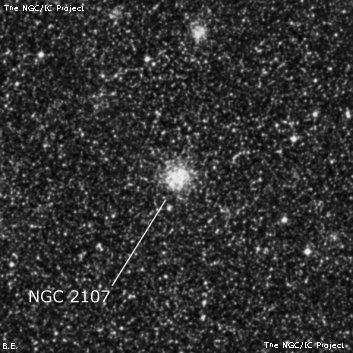
NGC 2107 is surrounded by several small clusters (these were all picked up just examining the field): S-L 691 and S-L 692, a close pair of open clusters, is 5' ESE, S-L 676 is 4' N, S-L 684 is 5' NNE and H-S 398 is 9' NNW.
S-L 676: moderately bright and large, round, 35" diameter, smooth glow with no resolution. S-L 684 is 2.4' ENE.
S-L 684: fairly faint to moderately bright, smooth glow, 25" diameter, roundish, no resolution.
S-L 691: faint or fairly faint, small, round, glow, 25" diameter. S-L 691 is the northern of close pair of LMC clusters with S-L 692 just 48" S.
S-L 692: fairly faint, fairly small, slightly elongated glow, 35" diameter, no resolution.
H-S 398: moderately bright, fairly small, round, soft glow, no resolution.
John Herschel discovered NGC 2107 = h2971 on 9 Feb 1836 and described as "F; R; gvlbM; 60"." On a second sweep he recorded "B; R; gmbM; 40"." His position is accurate.
Pietro Baracchi observed the cluster on 11 Dec 1884 with the 48" Melbourne telescope. At the same time he discovered two other clusters in the field; S-L 676 and S-L 684. He sketched these clusters with respect to NGC 2107 and measured offsets, though these discoveries were never published. On 10 Feb 1885 he reobserved the field and also discovered S-L 692.
600/800mm - 30" (10/13/15 - OzSky): at 394x; very bright, large, round, 1' diameter. Contains a very large bright core with only a thin fainter halo, slightly mottled appearance but no clear resolution. Two mag 12 and 13 stars are 3' and 4' WSW and two mag 12.5 and 13 star lie 3.5' and 4' WNW.
Notes by Steve Gottlieb